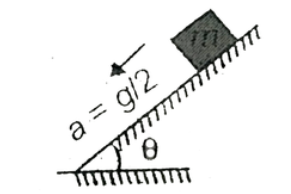A block placed on an inclined plane making an angle 17∘ with the horizontal slides down without any acceleration. What is the acceleration of the block if the inclimation is increased to 30∘ ?
The correct Answer is:2.35m/s2
To solve the problem step by step, we need to analyze the forces acting on the block on the inclined plane and calculate the acceleration when the angle of inclination is increased from 17∘ to 30∘.
Step 1: Understand the Forces Acting on the Block
When the block is on the inclined plane at an angle of 17∘, it is sliding down without any acceleration. This means that the forces acting on the block are balanced. The forces acting on the block include:
- The gravitational force mg acting downwards.
- The normal force R acting perpendicular to the inclined plane.
- The frictional force Fr acting up the incline.
Step 2: Calculate the Forces at 17∘
The gravitational force can be resolved into two components:
- Perpendicular to the incline: mgcos(17∘)
- Parallel to the incline: mgsin(17∘)
Since the block is in equilibrium (no acceleration), we can write:
mgsin(17∘)=Fr
Where the frictional force Fr is given by:
Fr=μR=μmgcos(17∘)
Setting these equal gives:
mgsin(17∘)=μmgcos(17∘)
Dividing both sides by mg (assuming m≠0):
sin(17∘)=μcos(17∘)
From this, we can find the coefficient of friction:
μ=sin(17∘)cos(17∘)=tan(17∘)
Step 3: Analyze the Forces at 30∘
Now, we need to analyze the situation when the angle is increased to 30∘. The forces acting on the block will now be:
- Perpendicular to the incline: mgcos(30∘)
- Parallel to the incline: mgsin(30∘)
The frictional force Fr will still be:
Fr=μR=μmgcos(30∘)
Step 4: Write the Equation of Motion
The net force acting on the block when it is at 30∘ is:
Fnet=mgsin(30∘)−Fr
Substituting for Fr:
Fnet=mgsin(30∘)−μmgcos(30∘)
Using a=Fnetm:
a=gsin(30∘)−μgcos(30∘)
Step 5: Substitute Known Values
We know:
- sin(30∘)=12
- cos(30∘)=√32
- μ=tan(17∘)≈0.305
Substituting these values:
a=g(12)−(0.305)g(√32)
Step 6: Simplify the Expression
Let’s calculate:
a=g(12−0.305⋅√32)
Calculating 0.305⋅√32≈0.305⋅0.866≈0.264:
a=g(12−0.264)=g(0.236)
Assuming g≈10m/s2:
a≈10⋅0.236=2.36m/s2
Final Answer
Thus, the acceleration of the block when the incline is increased to 30∘ is approximately 2.36m/s2.
---
When the block is on the inclined plane at an angle of 17∘, it is sliding down without any acceleration. This means that the forces acting on the block are balanced. The forces acting on the block include:
- The gravitational force mg acting downwards.
- The normal force R acting perpendicular to the inclined plane.
- The frictional force Fr acting up the incline.
The gravitational force can be resolved into two components:
- Perpendicular to the incline: mgcos(17∘)
- Parallel to the incline: mgsin(17∘)
mgsin(17∘)=Fr
Where the frictional force Fr is given by:
Fr=μR=μmgcos(17∘)
mgsin(17∘)=μmgcos(17∘)
sin(17∘)=μcos(17∘)
μ=sin(17∘)cos(17∘)=tan(17∘)
Now, we need to analyze the situation when the angle is increased to 30∘. The forces acting on the block will now be:
- Perpendicular to the incline: mgcos(30∘)
- Parallel to the incline: mgsin(30∘)
Fr=μR=μmgcos(30∘)
The net force acting on the block when it is at 30∘ is:
Fnet=mgsin(30∘)−Fr
Substituting for Fr:
Fnet=mgsin(30∘)−μmgcos(30∘)
a=gsin(30∘)−μgcos(30∘)
We know:
- sin(30∘)=12
- cos(30∘)=√32
- μ=tan(17∘)≈0.305
a=g(12)−(0.305)g(√32)
Let’s calculate:
a=g(12−0.305⋅√32)
a=g(12−0.264)=g(0.236)
a≈10⋅0.236=2.36m/s2
Thus, the acceleration of the block when the incline is increased to 30∘ is approximately 2.36m/s2.
Topper's Solved these Questions
Similar Questions
A block slides down an inclined plane that makes an angle θ with the horizontal. If the coefficient of kinetic friction is μ, find the acceleration of the block.
View SolutionA block slides down a frictionless, inclined plane that makes a 30∘ angle with the horizontal. Find the acceleration of this block.
View SolutionA block is placed on a smooth inclined plane at an angle 'θ' to the horizontal. The acceleration must the plane be moved horizontally so that the block to fall freely is
View SolutionA block of mass 2 kg rests on a rough inclined plane making an angle of 30° with the horizontal. If μS=0.6 , what is the frictional force on the block ?
View SolutionAn inclined plane makes an angle of 60∘ with horizontal. A disc rolling down this inclined plane without slipping has a linear acceleration equal to
View SolutionA block is at rest on an inclined plane making an angle α with the horizontal. As the angle of the incline is increased the block start slipping when the angle of inclination becomes θ then coefficient of friction is equal to
View SolutionAn inclined plane makes an angle 30° with the horizontal. A solid sphere rolling down this inclined plane from rest without slipping has a linear acceleration equal to
View SolutionA block of mass m slides down a rough inclined plane with an acceleration g2

View SolutionA block can slide on a smooth inclined plane of inclination θ kept on the floor of a lift. When the lift is descending with a retardation a , the acceleration of the block relative to the incline is
View SolutionA block can slide on a smooth inclined plane of inclination θ kept on the floor of a lift. When the lift is descending with a retardation a , the acceleration of the block relative to the incline is
View Solution
